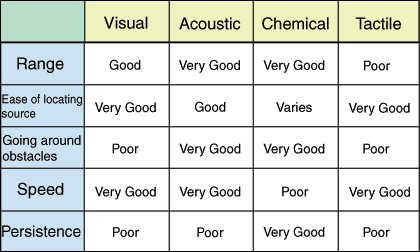Representational Information
Most displays reveal information about the signaler, whether it be fitness, disposition, or location. Representational information imparts information about the environment external to the sender. This is a more complicated form of communication, as it requires first assimilating information about the environment, and then divulging that information to others. The honeybee dance language is an example of representational information, imparting both the distance and the direction from the hive to food. A forager will return from a food source and, by performing a directed series of movements, can inform a second wave of foragers as to the location of the same food source.
Acoustic Signals
Acoustic signals are energetically costly, but can travel great distances, degrading with increasing distance. Many animals produce sounds to impart information, however only humans have a well-developed language. There is some evidence that Vervet monkeys have a language consisting of three distinct words: snake, eagle, and leopard. As it turns out, these alarm calls actually represent the type of threat, rather than the specific type of predator. The snake call warns conspecifics of the presence of a slow predator on the ground. Vervets respond to this call by standing up and looking around. The eagle call indicates a fast-flying predator. Vervets will run for cover and look up. The leopard call alerts the monkeys to a fast-running predator, and they respond by running up a tree. We will learn more about acoustical signals, namely song, in the section on Bird Song.
Tactile Signals
Physical contact is limited in its ability to communicate because it is extremely short-range. Many invertebrates use antennae as the first line of contact with objects and organisms. The honeybee waggle dance used to explain the location of a food source is often performed in a dark hive, and so the foragers receive their information by interpreting the dance with their antennae. The most common use of tactile communication occurs during copulation. Tactile stimulation by males will often let a female know when to adopt a sexually receptive posture, as in rodents. In primates, grooming is an extremely important social activity. It functions to remove parasites, but also to secure social bonds. This is also true of humans, for whom touch is an initimate form of communication.
Electrical Signals
Sharks and some fish have electroreceptors that are used to detect objects and to socially communicate. Electrolocation is a form of autocommunication; signalers send and receive their own signals. The difference between the emitted and received signals yield information about the environment through which the signal has passed. Species that use electrical signals for social communication are nocturnal or inhabit murky waters where visual communication is limited. Electrical signals are useful because they are extremely precise; they are limited to use in aquatic environments, though, because air is ineffective as an electrical insulator or conductor.
Comparison of Signal Types
As we have seen, a wide variety of signals are used in animal communication. Of course, each has its advantages and disadvantages, and are more useful in certain situations than in others. Otherwise, evolution would have only produced one type. In , we can see a comparison of visual, acoustic, chemical, and tactile signals. Acoustic and chemical signals are useful when obstacles stand between the signaler and the receiver, whole tactile and visual signals are not useful unless there is a clear path. Chemical signals can persist for long periods of time, while other signal types occur in real time, and so are only fleeting messages.














